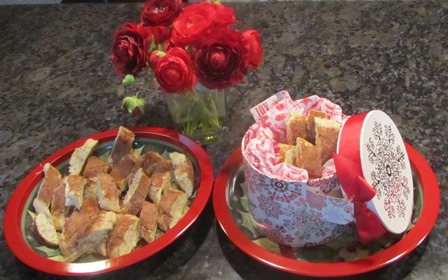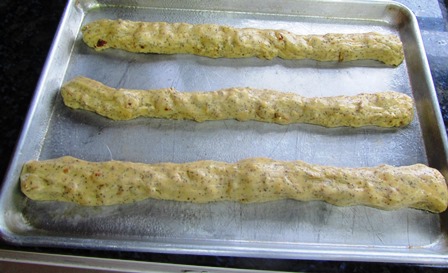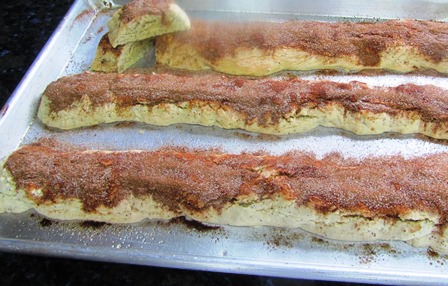Making Holiday Mandelbrot
Before my husband passed away at 46 from complications after a heart transplant, he used to accompany our son and his boy scout troop to Dodge Ridge for an annual ski trip (depending on the snow levels). The mandelbrot (twice-baked biscotti) I packed for them was always a hit, and each year the scouts would request it.
Making this biscotti has become an annual tradition for me at this time of year. I usually make several batches, dividing the dough into equal size balls first and then molding them into logs for baking. Mandelbrot is a Yiddish word, meaning almond bread (“mandel” for almond, “brot” for bread).
The pieces should be stored in an airtight container for gift-giving or for parsing out over the holidays with a hot cup of tea or mulled wine (my favorite mulled wine recipe relies on a ratio of 6-2-1 of claret, cider, and orange juice, plus honey and spices and citrus peel).
Our Family Favorite Mandelbrot
Ingredients:
1 cup sugar
3 eggs
3/4 cup canola oil
1 teaspoon vanilla
1/2 teaspoon almond flavoring
3 cups flour
1 teaspoon baking powder
dash of salt
2 tablespoons poppy seeds
1 cup coarsely chopped almonds (alternatively: pecans or walnuts)
Directions:
Set oven to 350 degrees Fahrenheit
Spray oil over a baking sheet.
Cream together sugar, eggs, oil, vanilla, and almond flavoring in the large bowl of an electric mixer.
Add flour, baking powder, salt, poppy seeds, and nuts and blend well.
Divide the dough into three equal balls.
Roll each ball in your hands to make a long roll, the length of the cookie sheet.
Repeat the process with the remaining two balls.
Place the three rolls at least 2 inches apart on the cookie sheet (they’ll expand and flatten slightly during the baking).
Bake for 20 minutes (the rolls will appear golden brown)
Remove from heat and let cool while you make the topping.
Topping:
Whisk together 2 tablespoons of sugar and 2 tablespoons of cinnamon until thoroughly blended.
Sprinkle the rolls with the cinnamon-sugar topping.
Return the biscotti to the oven for approximately 2 to 3 minutes.
Remove and let cool.
Make 2-inch wide slashes on the diagonal.
Store the biscotti in an airtight container.
For more delicious recipes, farming tips, and a cozy whodunnit, check out my newest novel, available on Amazon, Barnes & Noble, and other online and brick-and-mortar stores.
Buying Fair Trade Generates More than Good Taste
We all love our local farmers’ markets where the freshest organic ingredients–direct from the farm to our tables–are easy to find and purchase. And they taste so good. But sometimes, we consumers desire something grown beyond America’s borders, such as tea, coffee, exotic spices, and chocolate. And this is where choice and purchasing power has consequences.
When you choose to buy products displaying a FAIR TRADE certification logo, your action directly and positively impacts the lives of farmers, growers, artisan craftspeople, commodities producers, and their workers in communities in developing nations.
As consumers demand better products and better working conditions for workers, the Fair Trade movement has more clout to lobby on behalf of commodity farmers, impoverished workers, and child laborers.
If you love chocolate, consider this: seventy percent of the world’s cocoa beans is produced in Cote d’Ivoire and other Western African countries. Pay is nominal at $2 USD/per dieum and, according to UNICEF, more than a half million children labor under dire working conditions in the cocoa fields in these bean-producing countries even though child labor is illegal in the cocoa industry.
Coffee was one of the first Fair Trade certified products but today’s consumers can now also find Fair Trade certified cocoa, wine, cotton, fruit, tea, red palm oil, coconut oil and associated products, chocolate, honey, quinoa and other ancient grains, beans, sugar, and bananas, to name a few items.
The Fair Trade Movement has been around since mid last century. It began as a mainly North American/European social movement to aid poor farmers, commodity producers, and laborers in developing nations to achieve more favorable trading conditions. Fair Trade also promotes sustainability.
Choosing to buy a product carrying the Fair Trade certification label means your consumer decision will impact more than your taste buds–it will have positive ramifications for workers, commodity producers, and their communities beyond America’s borders.
 Facebook
Facebook Goodreads
Goodreads LinkedIn
LinkedIn Meera Lester
Meera Lester Twitter
Twitter







